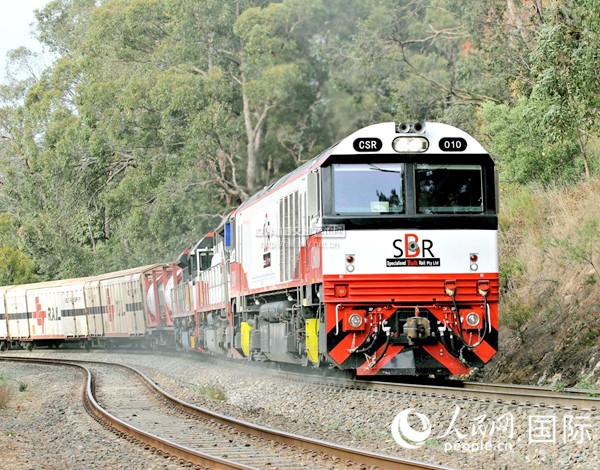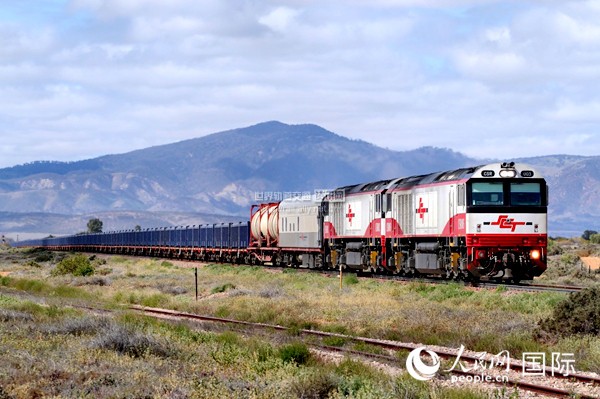CRRC locomotives exported to Australia: entering a new stage of high-quality BRI development
2019-05-09 09:10:16
A locomotive exported to Australia by CRRC Ziyang Co., Ltd. (Photo provided by CRRC Ziyang Co., Ltd.)
CRRC Ziyang Co., Ltd. (abbreviated as CRRC hereinafter), which belongs to CRRC Corporation Limited, was established in 1966. It is mainly engaged in the manufacture of diesel and electric locomotives. In recent years, CRRC has firmly grasped the opportunities of the Belt and Road Initiative (BRI), actively expanding its international market. Until now, it has provided more than 800 diesel locomotives to 25 countries and regions, of which about 95 percent of locomotive products have been exported to countries along the Belt and Road. It gives the "domestic time-honored brand" new vitality.
In 2010, the first AC drive diesel locomotive manufactured by CRRC was exported to Australia. This was also the first time that China had shipped a high-end diesel locomotive to a developed country. It indicated that CRRC had made progress in high-quality development. To date, CRRC has exported 18 diesel locomotives to Australia. SCT and QUBE, the top 10 logistics companies in Australia, purchased 12 and six locomotives respectively. To begin with, diesel locomotives from CRRC were mainly used to transport iron ore. With the decline of the Australian mining industry, the trains are now mainly used to transport containers, including food and daily necessities.
Australian freight railways are privately owned and divided according to regions. CRRC locomotives need to pass the admission tests of many railway companies before they can be used on these railways. The road sections, scope, conditions and requirements tested by various railway companies are different. CRRC had to pass the American standards which are used for Australian locomotive certification - one of the highest standards in the world.
To cope with the tests, CRRC sent a technical team to Australia before developing the locomotives. They inspected the Australian railway lines and communicated with the crews. They learned more about the locomotive's operating environment, consumer habits and admission standards. The inspection would help to assist the development of trains to comply with Australian market requirements. CRRC strictly adhered to more than 60 international standards to ensure that the locomotives had an excellent overall performance and quality. CRRC explored the possibility of high-quality BRI development, respecting the laws of the local markets, obeying international standards, working on technological innovation and contributing to local economic development.

An SDA1 locomotive of SCT Logistics (Photo provided by CRRC Ziyang Co., Ltd.)
At the beginning of the project, a company called SCT logistics also sent a team to CRRC. The two parties adhered to the principle of achieving shared growth through discussion and collaboration. They cooperated closely throughout the whole process of design, demonstration, manufacturing and testing. As a result, their products met the local requirements in Australia. Meng Yufa, deputy director of CRRC's R&D department, said that in the process of locomotive manufacturing and testing, each significant process had to be verified by the Australian side before they could enter the next stage. It took more than one year for the SDA1 locomotive to pass Australian testing and successfully launch.
CRRC started certification testing in Australia in 2012. The tests covered more than 30 items including noise, braking, electromagnetic compatibility and traction performance. Among them, the traction performance test was the most challenging. This "big exam" was carried out on the Coober Pedy to Port Augusta section of South Australia. The train was required to pull goods with a total length of 1,300 meters, 87 carriages, and a total weight of 8,337 tons. With the world's most advanced technology, the CRRC locomotives passed the ARTC Railway Company certification tests.
In 2016, in the case of changing the locomotive control mode and increasing technical difficulties, CRRC again passed the traction performance test. The test was carried out on railway from the Hawkesbury River to the Cowan Bank. The length of the railway is 8.58 km, of which 75 percent is a steep slope of more than 25 thousandths (the slope of the general railway does not exceed 20 thousandths). Moreover, it is a continuous S-shaped section. Due to its difficulty, the test is known as the "devil's corner." After the first test failed, the team, led by Meng Yufa, quickly discovered the problem and spent more than two months researching and fixing it. The second test was canceled due to a storm, but they managed to pass the certification test in the third trial.
CCRC has proven the technical innovation and green development of diesel locomotives along the Belt and Road. The SDA1 train has low operating noise, less than 75 decibels inside and 87 decibels outside. Locomotive availability has reached 96 percent, which means that in addition to failure and maintenance time, the locomotive can run for more than 350 days a year. The locomotive can tow more than 8,000 tons and tops out at a maximum speed of 120 kilometers per hour. Paul Hewison, an engineer from SCT, said that the locomotives from CRRC are one of the world's best, which meet the high requirements of the Australian railway industry with the lowest emissions, the highest power in the same axle weight, and the most reliable structural locomotives.
The introduction of CRRC's high-tech locomotives not only directly reduced the running costs for Australian logistics companies, but also injected competitive factors into the Australian locomotive market. After more than seven years of operation in Australia, CRRC has accumulated a large amount of data on locomotive operations and has a thorough understanding of the Australian market and standards. At the same time, it has also cultivated a business and technical team with global capabilities to help further explore the international market. The cooperation between Chinese and Australian enterprises on the locomotive project is a testimony to the fact that China and developed countries could have mutual benefits and win-win results under the Belt and Road Initiative.
